Stand-Out Designs for Stand-Alone Containers: Part 2
More ideas for solo pots that make a strong impression

Give typical home owners a pot, and they will likely plant it up and place it near one of the entries to the home. But stand-alone containers can make dramatic impressions in a variety of spaces. Bowls or boxes in the corners of patios look great when planted with interesting succulents or mixed annuals. Pots can also be placed on outdoor coffee tables as conversation pieces. The center of a courtyard is always a great place for a tall planter that generates interest for pedestrians walking by. Window boxes are an easy way to brighten up the views from indoor spaces and frame uninspiring windows. As you can see, there are few places where a single container doesn’t make a positive impact.
Check out more stand-alone container designs in Part 1 here!
Dress up a drab corner
Corners offer great exhibition opportunities, so don’t let them go unplanted. ‘Swane’s Gold’ cypress is much more interesting to look at than a wall. The sweet potato vine picks up the yellow-green theme, and some red annuals provide a shot of contrast.
- ‘Swane’s Gold’ cypress (Cupressus sempervirens ‘Swane’s Gold’, Zones 7–9)
- ‘Wendy’s Wish’ salvia (Salvia ‘Wendy’s Wish’, Zones 9–11)
- ‘Sweet Caroline Light Green’ sweet potato vine (Ipomoea batatas ‘Sweet Caroline Light Green’, Zone 11)
- Great Cascade™ Wine Red creeping gloxinia (Lophospermum erubescens ‘Sunasaro’, Zones 10–11)
- Superbells® Coralberry Punch calibrachoa (Calibrachoa ‘USCAL66501’, annual)
Entryway beacons

This tall orange arrangement stands bright against the gray home, drawing visitors toward the semihidden doorway. Use plants like this bright canna and this coleus in combinations that need to be seen from a distance. They work as social cues for visitors, and they add a soft touch to hard edges.
- ‘Sky Fire’ coleus (Solenostemon scutellarioides ‘Sky Fire’, Zones 12–13)
- Tropicanna® canna (Canna indica ‘Phasion’, Zones 8–11)
- Purple fountain grass (Pennisetum setaceum* ‘Rubrum’, Zones 8–11)
- Eternal Flame™ cuphea (Cuphea ‘Eternal Flame’, Zones 7–10)
- Callie™ Orange calibrachoa (Calibrachoa ‘Callie Orange’, annual)
- ‘Sweet Caroline Purple’ sweet potato vine (Ipomoea batatas ‘Sweet Caroline Purple’, Zone 11)
- Sunset Strip™ coleus (Solenostemon scutellarioides ‘Sunset Strip’, Zones 12–13)
Just a little contrast
The rich cedar siding is reflected by coleus cultivars with bronze details and by an impatiens with red flowers. The creeping Jenny lights up the pot without seeming out of place.
- ‘Dipt in Wine’ coleus (Solenostemon scutellarioides ‘Dipt in Wine’, Zones 12–13)
- ‘Tilt-a-Whirl’ coleus (Solenostemon scutellarioides ‘Tilt-a-Whirl’, Zones 12–13)
- Spitfire™ coleus (Solenostemon scutellarioides ‘Spitfire’, Zones 12–13)
- Super Elfin™ Scarlet impatiens (Impatiens walleriana Super Elfin™ Scarlet, annual)
- ‘Goldilocks’ creeping Jenny (Lysimachia nummularia* ‘Goldilocks’, Zones 4–8)
Succulents add quiet color
These succulents set a calm tone, while the aeonium tops them off with subdued drama. Succulents like these are striking alternatives to plants with loud or bright colors.
- ‘Zwartkop’ aeonium (Aeonium arboreum ‘Zwartkop’, Zones 9–11)
- Lavender scallops (Kalanchoe fedtschenkoi, Zone 13)
- Fire and Ice™ echeveria (Echeveria subrigida, Zones 9–11)
- ‘Serpents’ blue chalk fingers (Senecio vitalis ‘Serpents’, Zones 10–11)
- Burro’s tail (Sedum morganianum, Zone 11)
- ‘Chocolate Ruffles’ echeveria (Echeveria ‘Chocolate Ruffles’, Zones 10–11)
- ‘Ogon’ sedum (Sedum makinoi ‘Ogon’, Zones 6–9)
- Crassula (Crassula sp., Zone 11)
- ‘Lynn’s Choice’ hens and chicks (Sempervivum ‘Lynn’s Choice’, Zones 4–11)
If you plant just one, make it interesting
Baby jade all lined up in a window box is an easy-to-install source of interest because the plant itself is captivating. Its leaves are succulent and deeply tinted, and planting a slew of them simply underscores their uniqueness.
- Baby jade (Crassula ovata arborescens, Zones 9–11)
An easy hanging basket
Anyone who has planted hanging baskets knows they dry out—fast. Why not fill them with plants that like it dry? Tall, bushy specimens, like blue chalk fingers and flapjacks, are easy to spot from below, as are trailers, like weeping jade and string of beans, which spill over this basket’s edge. Avoid short and flat varieties because they will be invisible up high.
- ‘Serpents’ blue chalk fingers (Senecio vitalis ‘Serpents’, Zones 10–11)
- Sedum (Sedum dendroideum, Zones 9–11)
- Flapjacks (Kalanchoe thyrsiflora, Zone 11)
- ‘Ogon’ sedum (Sedum makinoi ‘Ogon’, Zones 6–9)
- String of beans (Senecio radicans, Zones 10–11)
- Pachyphytum (Pachyphytum longifolium, Zones 12–13)
- Weeping jade (Senecio jacobsenii, Zones 10–11)
- Firesticks (Euphorbia tirucalli ‘Rosea’, Zone 11)
Shaped for optimal viewing

Notice the three surfaces of this container: vertical at the back, with the dagger plant and kalanchoe; horizontal in front, with the echeverias; and another vertical plane down the pot’s front, with string of beans. Set up this way, every succulent is visible from head to toe.
- ‘Purpurea’ dagger plant (Yucca aloifolia ‘Purpurea’, Zones 12–13)
- Kalanchoe (Kalanchoe grandiflora, Zone 11)
- Rattail (Crassula muscosa, Zone 11)
- Afterglow™ echeveria (Echeveria ‘Afterglow’, Zones 9–11)
- String of beans (Senecio radicans, Zones 10–11)
- ‘Cape Blanco’ sedum (Sedum spathulifolium ‘Cape Blanco’, Zones 5–9)
- ‘Blue Rose’ echeveria (Echeveria imbricata ‘Blue Rose’, Zones 9–11)
- ‘Ogon’ sedum (Sedum makinoi ‘Ogon’, Zones 6–9)
Lime green is a good place to start

Without the shot of chartreuse, this understated combination might fade into the dark green background. But with the sweet potato vine in place, the eye is directed to the compelling flowering plants around it.
- ‘Tea Cup’ elephant’s ear (Colocasia esculenta* ‘Tea Cup’, Zones 8–11)
- King Tut® papyrus (Cyperus papyrus ‘King Tut’, Zone 11)
- Croftway™ Coral Princess Cape fuchsia (Phygelius ‘Croftway Coral Princess’, Zones 7–9)
- Bellfire® begonia (Begonia boliviensis Bellfire®, Zones 10–11)
- ‘Sweet Caroline Light Green’ sweet potato vine (Ipomoea batatas ‘Sweet Caroline Light Green’, Zone 11)
- Superbells® Coralberry Punch calibrachoa (Calibrachoa ‘USCAL66501’, annual)
- ‘Sweet Caroline Bewitched’ sweet potato vine (Ipomoea batatas ‘Sweet Caroline Bewitched’, Zone 11)
One plant, many looks
These hens and chicks are rendered magnificently by stuffing a great quantity of them into a single wide-mouthed pot. Because the plants share similar shapes and textures, focus shifts to scale and color when viewing the collection. Large hens and chicks look even more interesting when placed next to tinier versions of themselves. For a slightly more apparent effect, cobweb hens and chicks were added for their freakish sinewy secretions. Todd calls them “a staple for Sempervivum containers or baskets.”
- ‘Blue Boy’ hens and chicks (Sempervivum ‘Blue Boy’, Zones 2–9)
- ‘Elva’ hens and chicks (Sempervivum ‘Elva’, Zones 2–9)
- Cobweb hens and chicks (Sempervivum arachnoideum ssp. tomentosum, Zones 5–8)
The colorful brick in the wall

In a container-garden lineup, it’s wise to separate lively pots with simpler ones. This big, colorful canna-topped pot looks toned down among other green ones.
- Tropicanna® canna (Canna indica ‘Phasion’, Zones 8–11)
- Fuchsia (Fuchsia cv., Zones 9–10)
- Velvet Mocha® coleus (Solenostemon scutellarioides ‘Velvet Mocha’, Zones 12–13)
- ‘Big Red Judy’ coleus (Solenostemon scutellarioides ‘Big Red Judy’, Zones 12–13)
- Spitfire™ coleus (Solenostemon scutellarioides ‘Spitfire’, Zones 12–13)
- Callie™ Mango calibrachoa (Calibrachoa ‘Callie Mango’, annual)
- ‘Vesuvius Red’ flowering maple (Abutilon × hybridum ‘Vesuvius Red’, Zones 9–11)
- ‘Tara’ ginger (Hedychium gardnerianum ‘Tara’, Zones 7–11)
- ‘Sweet Caroline Sweetheart Red’ sweet potato vine (Ipomoea batatas ‘Sweet Caroline Sweetheart Red’, Zone 11)
Break up overly similar plants

Although coordination is impressive, too much of it is not a good thing. Variegated shell ginger and ‘Green and Gold’ plectranthus are similar in color and pattern, so breaking them up with a dark purple sweet potato vine and tossing some lively fuchsia blooms into the mix are great ways to use these plants in the same urn.
- Variegated shell ginger (Alpina zerumbet ‘Variegata’, Zones 8–11)
- ‘All Gold’ Japanese forest grass (Hakonechloa macra ‘All Gold’, Zones 5–9)
- Fuchsia (Fuchsia cv., Zones 9–10)
- ‘Green and Gold’ plectranthus (Plectranthus discolor ‘Green and Gold’, Zones 12–13)
- Sweet potato vine (Ipomoea batatas cv., Zone 11)
Designed by Lisa Gibson McMahon for her garden in Sauderstown, Rhode Island
Bamboo is kind to small plants
Mountain bamboo fills out with leaves toward its top, so its bare base is perfect for blending with low growers, like the sorrel and the begonia, because it won’t hide them.
- Mountain bamboo (Fargesia rufa, Zones 6–9)
- ‘Sweet Caroline Purple’ sweet potato vine (Ipomoea batatas ‘Sweet Caroline Purple’, Zone 11)
- Molten Lava™ sorrel (Oxalis vulcanicola ‘Molten Lava’, Zones 9–11)
- ‘Solenia Red’ begonia (Begonia ‘Solenia Red’, Zones 12–13)
- Black mondo grass (Ophiopogon planiscapus ‘Nigrescens’, Zones 6–11)
- ‘Goldilocks’ creeping Jenny (Lysimachia nummularia* ‘Goldilocks’, Zones 4–8)
- Eternal Flame™ cuphea (Cuphea ‘Eternal Flame’, Zones 7–10)
- ‘Sweet Caroline Bewitched’ sweet potato vine (Ipomoea batatas ‘Sweet Caroline Bewitched’, Zone 11)
A simple touch can make a world of difference

This container gets an A+ for coordination. The charming stone pot relates to the stone wall beneath it, and the purple shamrock connects visually to the hydrangea behind. A small yet thoughtful detail, like this one, is all it takes to tame a garden corner lacking a soft touch.
- Purple shamrock (Oxalis cv., Zones 9–11)
Designed by Crystal Brinson for her garden in Little Compton, Rhode Island
All sorts of reds blend handsomely
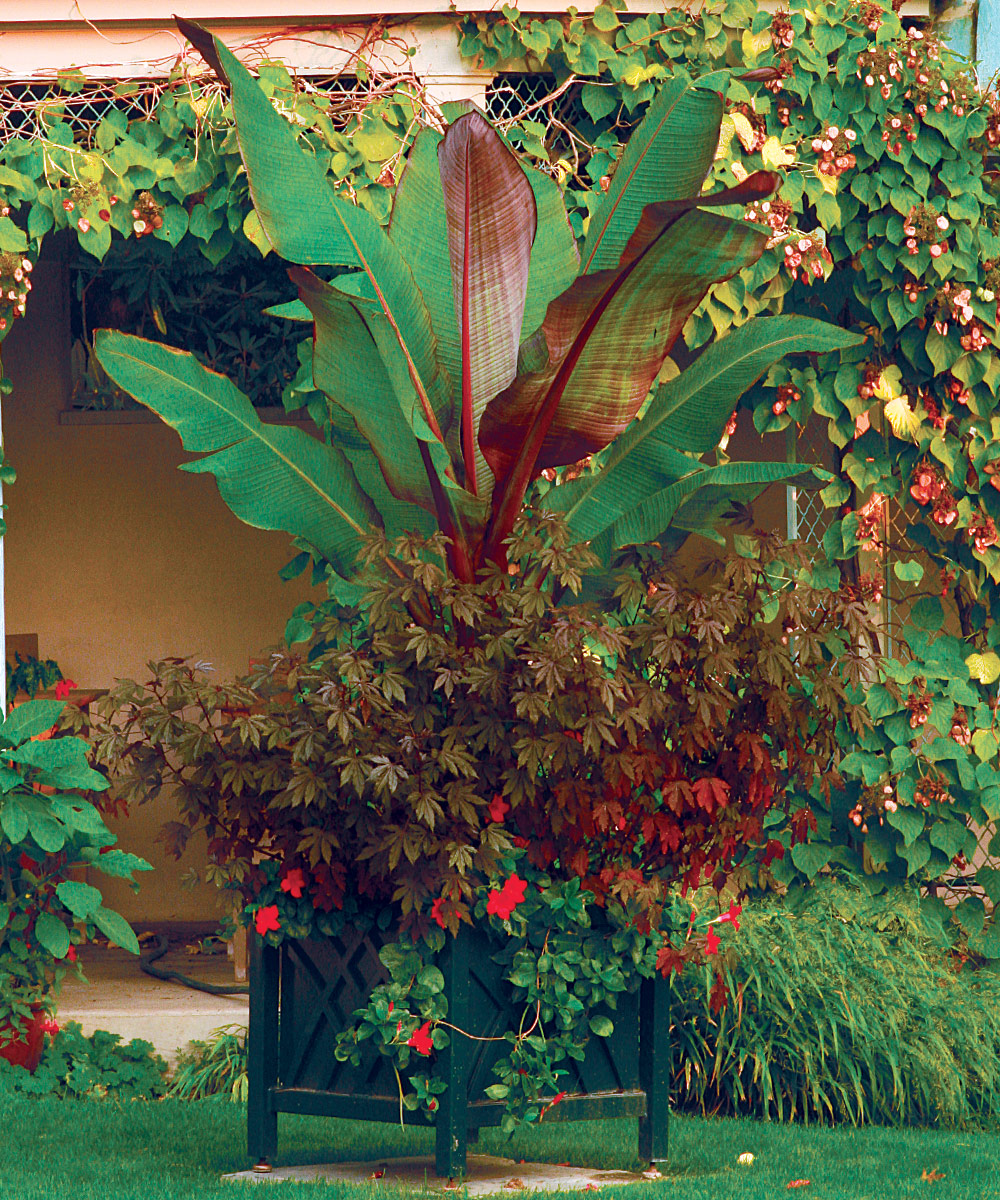
The reds in this box are different yet mix beautifully. The bright mandevilla catches the eye first from a place that is often seen last: the base. The eye moves up toward the burgundy flowering maple and then to the reds on the underside of the banana leaves.
- Red Abyssinian banana (Ensete ventricosum ‘Maurelii’, Zones 9–11)
- Flowering maple (Abutilon cv., Zones 8–11)
- Mandevilla (Mandevilla cv., Zone 11)
Designed by Dan Benarcik at Chanticleer in Wayne, Pennsylvania
Color groups temper each other

There are two color groups living in this pot: a dark-green-and-purple selection toward the top and a citrus-colored one at the base. Neither is too strong, and together they provide diverse color interest.
- Red Abyssinian banana (Ensete ventricosum ‘Maurelii’, Zones 9–11)
- Coleus (Solenostemon scutellarioides cv., Zones 12–13)
- Purple shamrock (Oxalis cv., Zones 9–11)
- Calibrachoa (Calibrachoa cv., annual)
- ‘Autumnale’ fuchsia (Fuchsia ‘Autumnale’, Zones 10–11)
Designed by Dean Engelmann for Tangletown Gardens in Minneapolis
A pot should suit its spot
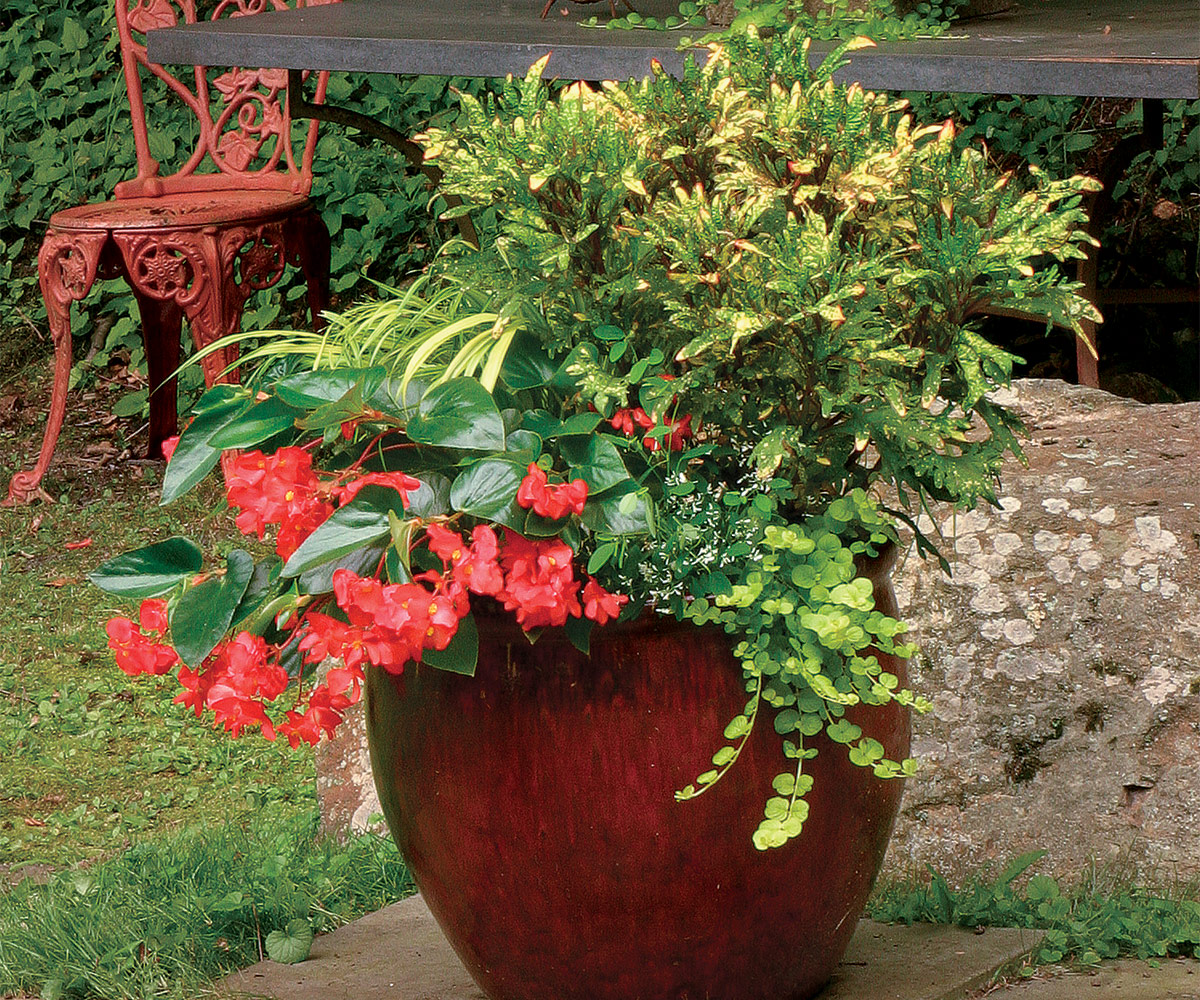
If you are in pursuit of a seamless design, then harmonize plants and garden ornaments. Here, an ornate oxidized chair matches a rusty pot that holds a begonia and a gorgeous collection of chartreuse foliage. The arrangement happens to coordinate splendidly with the pot on the table as well.
- Coleus (Solenostemon scutellarioides cv., Zones 12–13)
- ‘All Gold’ Japanese forest grass (Hakonechloa macra ‘All Gold’, Zones 5–9)
- Dragon Wing™ Red begonia (Begonia Dragon Wing™ Red, Zone 11)
- Diamond Frost® euphorbia (Euphorbia ‘Inneuphdia’, Zones 10–11)
- Golden creeping Jenny (Lysimachia nummularia* ‘Aurea’, Zones 4–8)
Designed by Stephanie Fagan for her garden in Newtown, Connecticut
A single shape emphasizes color

The leaves of the caladium, philodendron, and rex begonia vine are spade shaped, so focus quickly shifts to their colors and patterns. The range of pattern is forward and apparent, from the slick philodendron, with its yellow central vein, to the speckled caladium.
- Caladium (Caladium bicolor cv., Zones 10–11)
- Philodendron (Philodendron cv., Zone 13)
- Rex begonia vine (Cissus discolor, Zone 11)
Designed by Dan Benarcik at Chanticleer Garden in Wayne, Pennsylvania
*These plants are considered invasive in some areas. Please check invasiveplantatlas.org or your state’s list of invasive plants for more information.
—Todd Holloway is the owner of Pot Inc., a plant design firm, and creates premium landscape and garden planters in Vancouver, British Columbia.
Photos, except where noted: Joshua McCullough/phytophoto.com









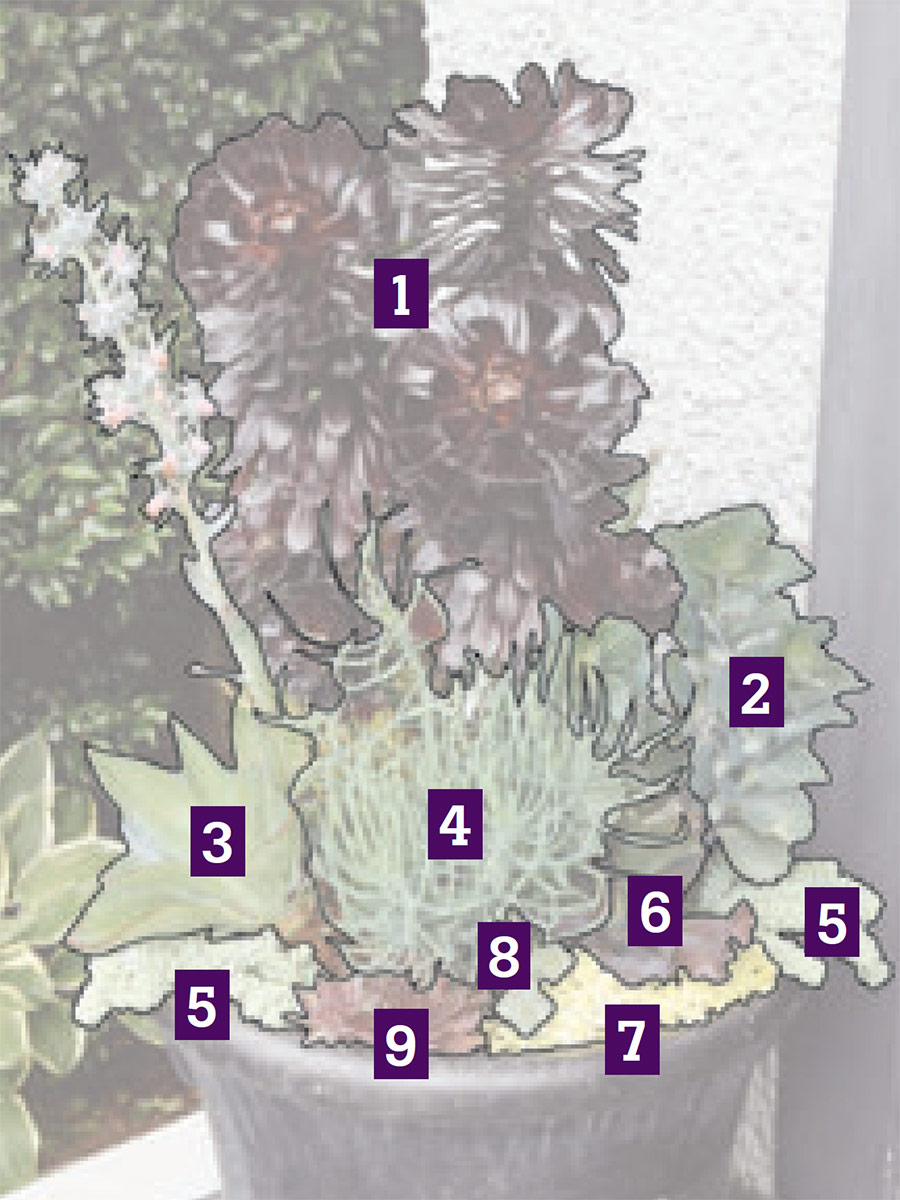
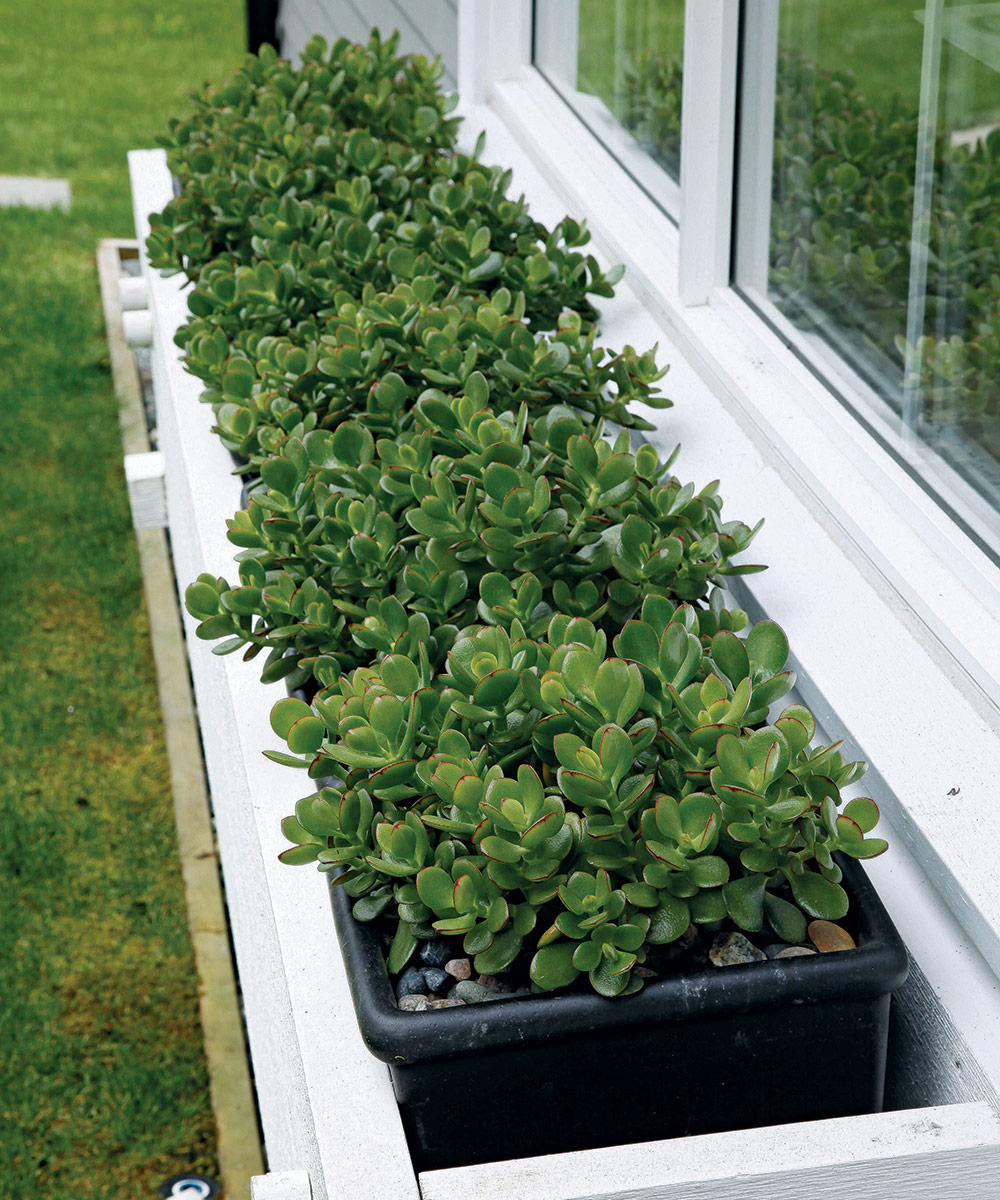




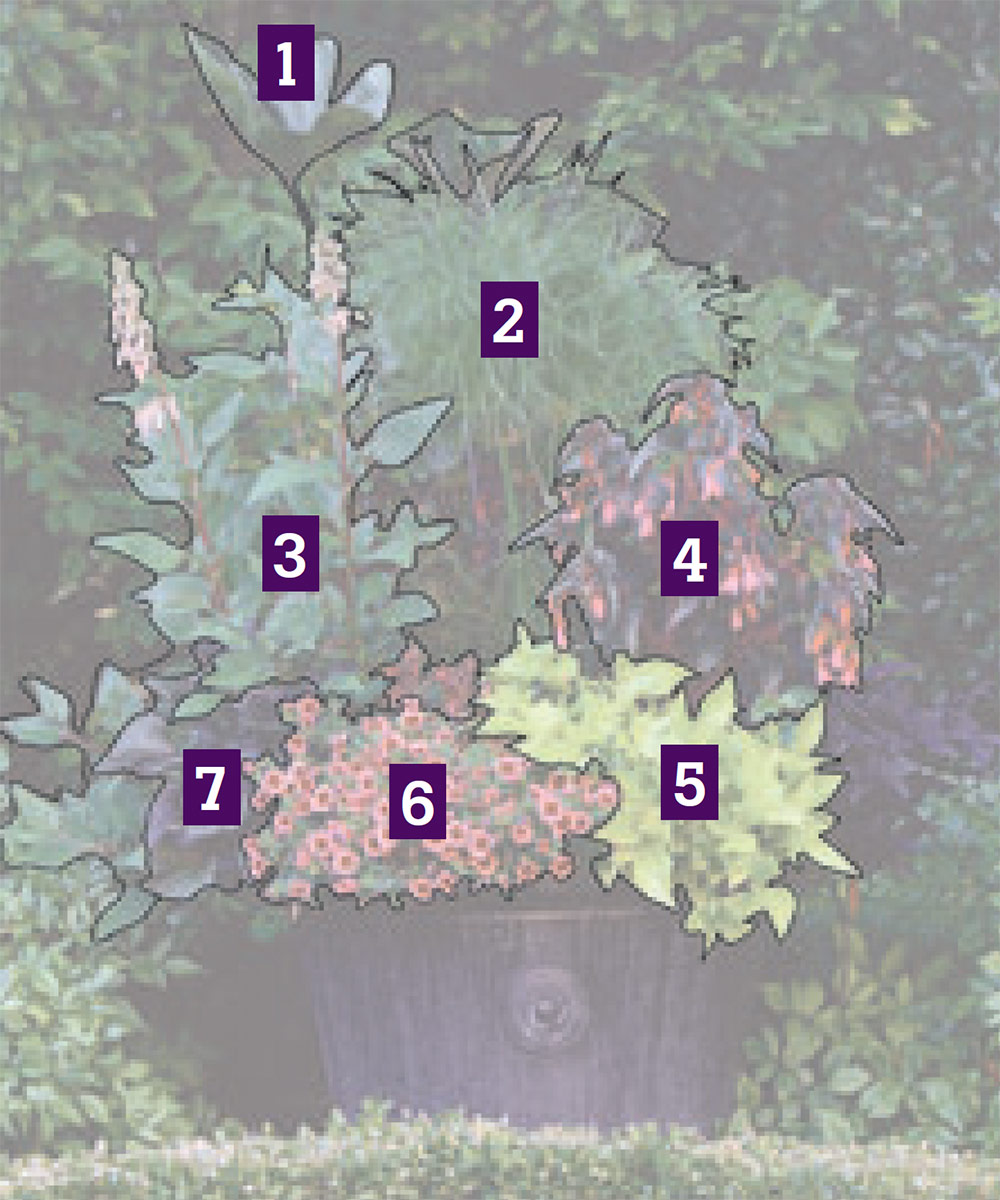
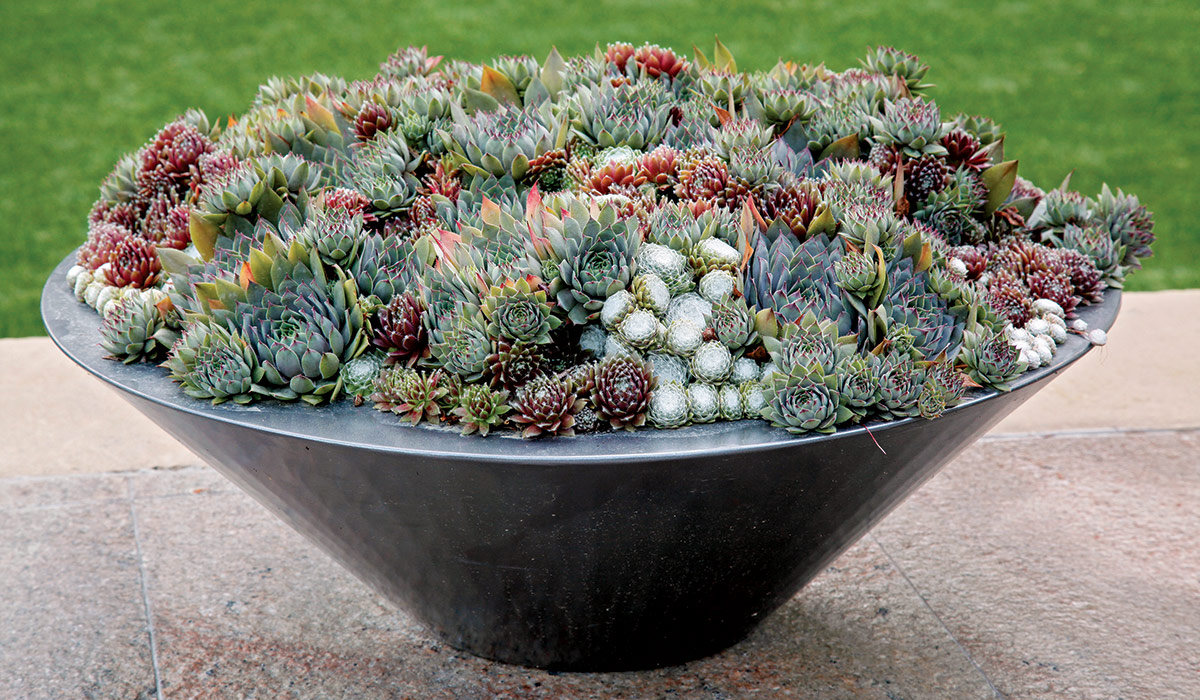
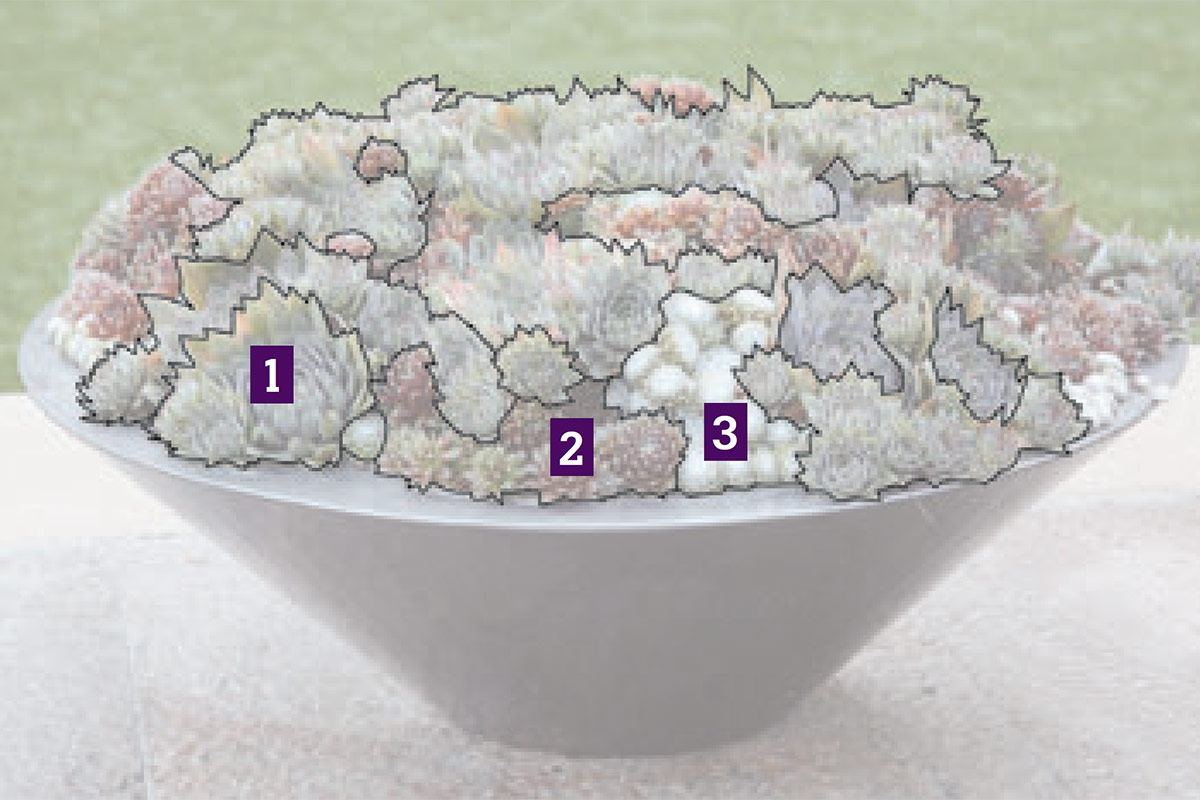





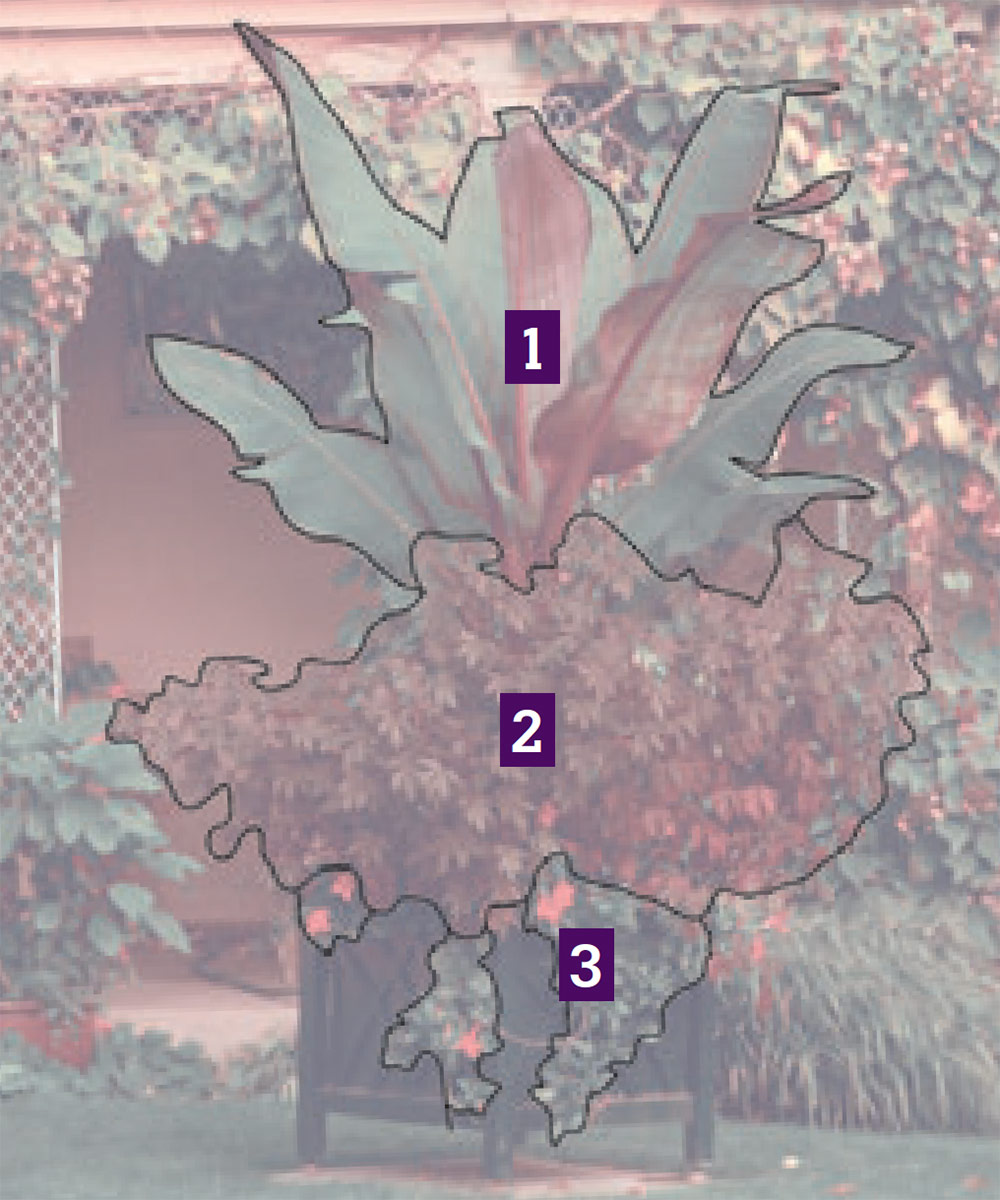
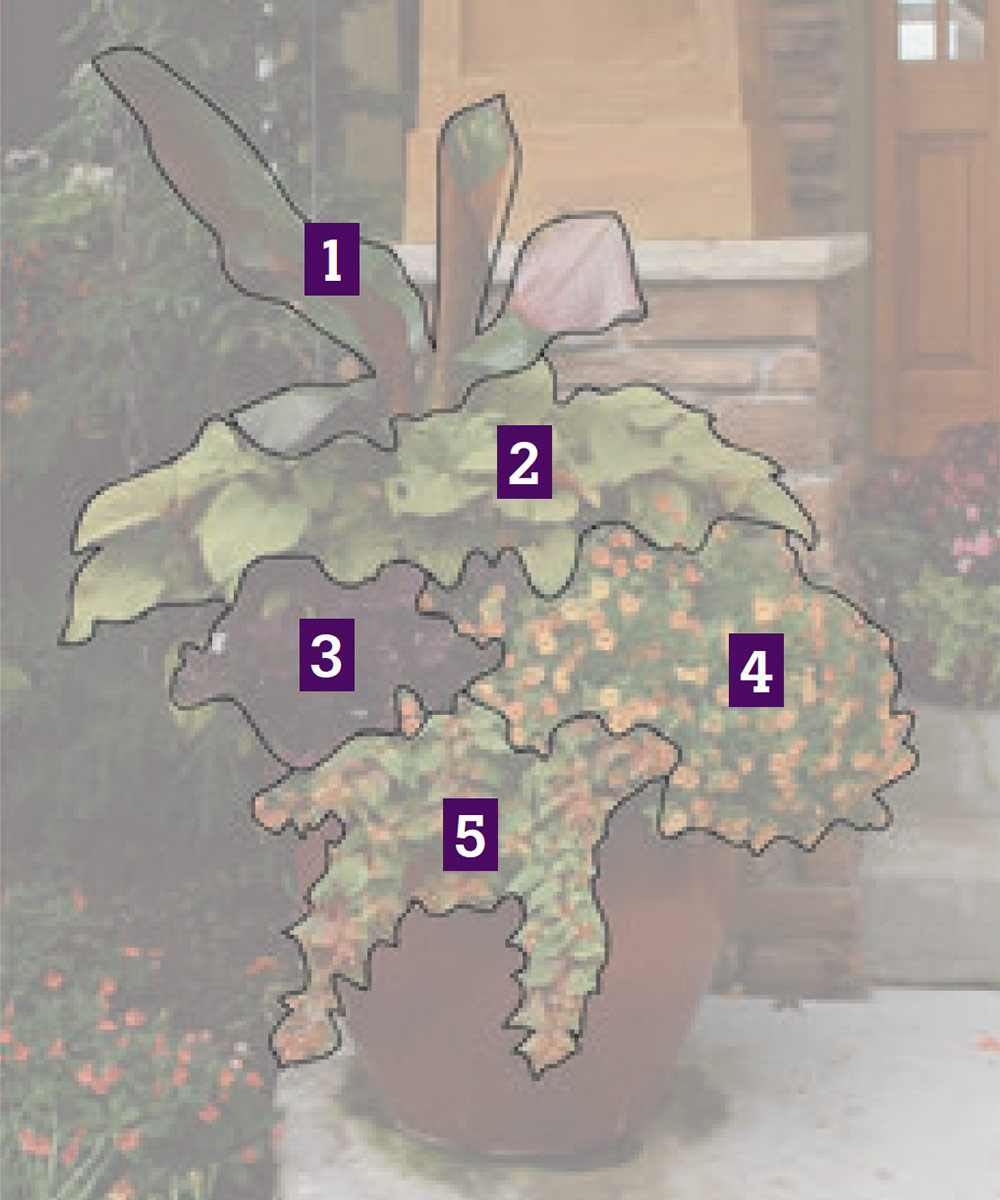





Comments
Log in or create an account to post a comment.
Sign up Log in